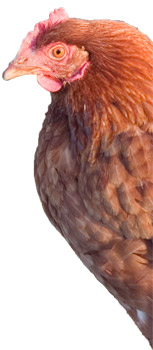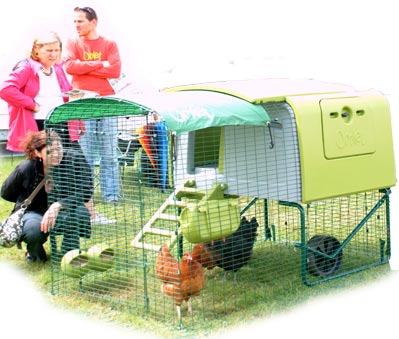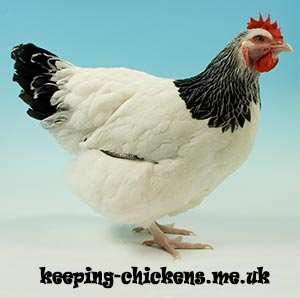Keeping a few chickens in the back yard really is quite straight forward; however there are some things to consider in order to get the right sort of birds for your situation and to keep them in the best possible health to get the most enjoyment out of keeping them.
This page hopes to get you thinking about the types of chickens and their requirements.
Choosing a breed
There are quite literally hundreds of different breeds of chicken to choose from and out of these, many have slightly different requirements.
Some breeds of chicken come only as Large Fowl, and others are also available as Bantams which are a smaller version that look the same. The Orpington for example is available in both large and bantam sizes but the Cochin is only available as large fowl.
There are a handful of ‘True Bantams’ where there is no large fowl equivalent. Examples of these are Dutch Bantams, Japanese Bantams and the popular Pekin Bantam.
Bantams tend to be quite flighty whereas the heavy breeds of large fowl often cannot fly more than a few inches off the ground. Orpingtons for example won’t usually roost very high due to their huge size and will usually just huddle on the floor of the coop.
Every breed is slightly different in the amount of eggs they lay. Typically hens that have been bred for exhibition purposes do not lay as well as utility hens. Bantams of course lay smaller eggs which some people say they prefer for taste.
Hybrids
 Hybrids are chickens that have been created by crossing pure breeds. They are typically crossed to make good layers (the hybrid to the right can lay 280 to 300 eggs!), coloured eggs or attractive hens. Some can be very attractive and they are all generally very hardy. Hybrids are produced in larger numbers that pure breeds and most of the crosses used make the males a different colour as day old chicks so that only females can be raised, therefore reducing costs by about half. A typical hybrid hen will cost you around £15 compare to £25 to £30 for a typical pure breed hen.
Hybrids are chickens that have been created by crossing pure breeds. They are typically crossed to make good layers (the hybrid to the right can lay 280 to 300 eggs!), coloured eggs or attractive hens. Some can be very attractive and they are all generally very hardy. Hybrids are produced in larger numbers that pure breeds and most of the crosses used make the males a different colour as day old chicks so that only females can be raised, therefore reducing costs by about half. A typical hybrid hen will cost you around £15 compare to £25 to £30 for a typical pure breed hen.
Hybrids are a good choice if eggs are one of your priorities although if you think you might like to hatch some eggs, remember hybrid hens do not breed true – you would need the original pure breeds to cross again in order to create more of the same thing so whilst you can hatch their eggs, you may want to consider a few pure breeds for this purpose or consider buying in eggs to hatch.
Free Range
You will of course need a chicken coop but also a secure run or area that is predator proof. A question that people always ask me is “How big should their run be?” I always say “as big as possible within reason.” Even 2 chickens kept in a 2 meter run will soon turn it to mud and get bored (which can introduce vices such as feather pecking and egg eating) but I always believe that it’s fine to provide a small run like this if you can let them out for a few hours each day to free range while you are around. This will give them a chance to forage, supplement their diet and reduce boredom.
Once chickens have settled into their new house, they will go back to it to roost every night so you can let them out in the late afternoon, knowing they will come back to roost at night keeping everyone happy! Some houses and runs have handles or wheels that make them easy to move onto fresh ground which is not only good to prevent a build up of worm eggs and disease but also provides them with a little fresh grass to graze.
Keeping Chickens in the Garden
If you have a ‘nice’ garden that you don’t want spoilt, it’s usually a sensible idea to limit their foraging. Chickens scratch at the ground, make dust baths in the dry soil, leave muck wherever they go and destroy tender young plants. If you can plant in pots, this will help and fencing off part of the garden is usually a good choice to keep them out if you have tender or precious plants. Chickens with feathered feet scratch less and bantams can clear a 6 foot fence if they want to. Heavy breeds of large fowl can be kept out with a knee high fence or box hedge. If you want to stop a bird from flying then you can clip one wing (not both).
So you have decided on the breed that’s right for you and your circumstances. Next, you will need to think about keeping them secure from predators in a suitable chicken house and chicken run – click on a link to go to that page!








Hi thinking of getting 3 chickens and have got a decent size lawn, if I was keeping them happy by getting a moveable coop how long would it take them to eat and scratch the grass away before they would need moving? Thanks
It depends on the grass, time of year, how much scratching the hens do and the run area – but as a general rule I’d say the run would need moving weekly.
Greetings. Loving the site. I would love some advice. I am looking after a friends 4 chickens. They seem to get on fine with each other but I recently got given another chicken, different breed, and two of the older chickens keep pecking her and chasing her around. She doesn’t fight back and she’s being prevented from entering the coop at dusk. This has been going on for nearly a week now and doesn’t seem to be getting any better. What can I do to aid her integration into the flock?
It can take some time for them to accept one another and even then, in these sort of situations, they will often continue bullying her.
The best thing is to give them as much space as you can and provide separate feeders / drinkers so the bullied hen can always get to food and water.
I am looking to have hens when I move abroad just that for low maintenance the gardens are covered in stones will it be advisable to put straw down
People normally use sand or hardwood chippings, sometimes fine smooth gravel (not bark because it can cause aspegilosis because of the mould spores damp bark can produce). Straw is possible but will soon become soiled and need changing.
Hi,
We are hoping to get some chickens. We have a large sloped area which is covered with grass and weeds (some knee high). There is also some small bits of rubble (including some bits of building insulation from a building project which are scattered and part buried). Would we need to cut the grass and weeds to a lower height and also would we need to thoroughly clear the area of any rubble/building materials? Thanks
Yes and yes! Short, green grass is nutritious but long, woody stems of grass isn’t and can cause problems like blocked or impacted crop. Building materials may not concern your chickens but you just can’t tell if they will peck at them and possibly eat some of it.
hi i would love to have a couple of hen but i only have a balcony was going to partition it off would it be ok
It is probably not going to be easy to look after them on a balcony and they wouldn’t be able to get any free range / exercise.